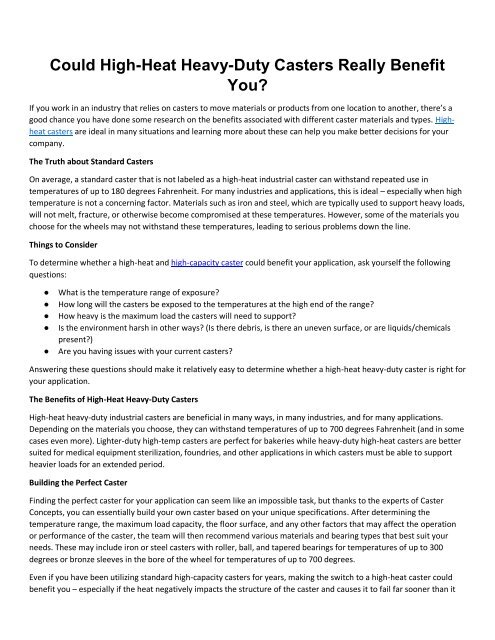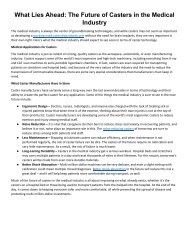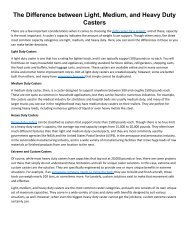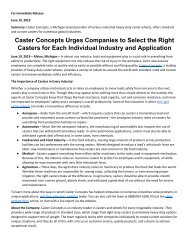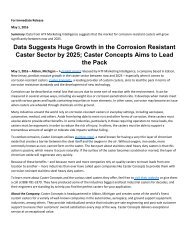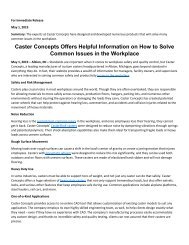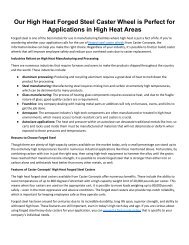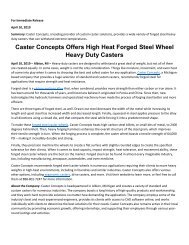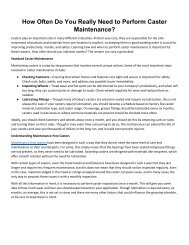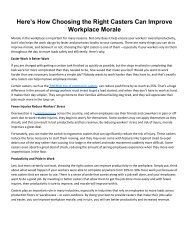Could High Heat Heavy Duty Casters Really Benefit You
Create successful ePaper yourself
Turn your PDF publications into a flip-book with our unique Google optimized e-Paper software.
<strong>Could</strong> <strong>High</strong>-<strong>Heat</strong> <strong>Heavy</strong>-<strong>Duty</strong> <strong>Casters</strong> <strong>Really</strong> <strong>Benefit</strong><br />
<strong>You</strong>?<br />
If you work in an industry that relies on casters to move materials or products from one location to another, there’s a<br />
good chance you have done some research on the benefits associated with different caster materials and types. <strong>High</strong>heat<br />
casters are ideal in many situations and learning more about these can help you make better decisions for your<br />
company.<br />
The Truth about Standard <strong>Casters</strong><br />
On average, a standard caster that is not labeled as a high-heat industrial caster can withstand repeated use in<br />
temperatures of up to 180 degrees Fahrenheit. For many industries and applications, this is ideal – especially when high<br />
temperature is not a concerning factor. Materials such as iron and steel, which are typically used to support heavy loads,<br />
will not melt, fracture, or otherwise become compromised at these temperatures. However, some of the materials you<br />
choose for the wheels may not withstand these temperatures, leading to serious problems down the line.<br />
Things to Consider<br />
To determine whether a high-heat and high-capacity caster could benefit your application, ask yourself the following<br />
questions:<br />
● What is the temperature range of exposure?<br />
● How long will the casters be exposed to the temperatures at the high end of the range?<br />
● How heavy is the maximum load the casters will need to support?<br />
● Is the environment harsh in other ways? (Is there debris, is there an uneven surface, or are liquids/chemicals<br />
present?)<br />
● Are you having issues with your current casters?<br />
Answering these questions should make it relatively easy to determine whether a high-heat heavy-duty caster is right for<br />
your application.<br />
The <strong>Benefit</strong>s of <strong>High</strong>-<strong>Heat</strong> <strong>Heavy</strong>-<strong>Duty</strong> <strong>Casters</strong><br />
<strong>High</strong>-heat heavy-duty industrial casters are beneficial in many ways, in many industries, and for many applications.<br />
Depending on the materials you choose, they can withstand temperatures of up to 700 degrees Fahrenheit (and in some<br />
cases even more). Lighter-duty high-temp casters are perfect for bakeries while heavy-duty high-heat casters are better<br />
suited for medical equipment sterilization, foundries, and other applications in which casters must be able to support<br />
heavier loads for an extended period.<br />
Building the Perfect Caster<br />
Finding the perfect caster for your application can seem like an impossible task, but thanks to the experts of Caster<br />
Concepts, you can essentially build your own caster based on your unique specifications. After determining the<br />
temperature range, the maximum load capacity, the floor surface, and any other factors that may affect the operation<br />
or performance of the caster, the team will then recommend various materials and bearing types that best suit your<br />
needs. These may include iron or steel casters with roller, ball, and tapered bearings for temperatures of up to 300<br />
degrees or bronze sleeves in the bore of the wheel for temperatures of up to 700 degrees.<br />
Even if you have been utilizing standard high-capacity casters for years, making the switch to a high-heat caster could<br />
benefit you – especially if the heat negatively impacts the structure of the caster and causes it to fail far sooner than it
should. Talk to the experts at Caster Concepts today to find the perfect combination of materials and designs for your<br />
industry.


